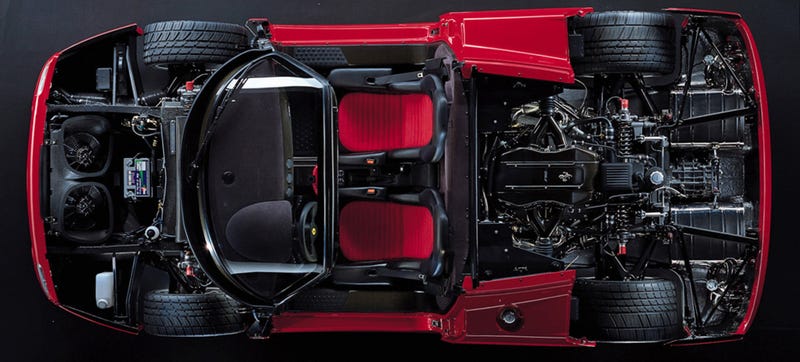
 The Ferrari F50 Was The Last F1 Engined Road Car- The Ferrari F50 is often remembered as a flop: it was slower than the car it replaced and for years its styling was absolutely reviled. I think the problem was that the thing was built 60 years too late, and it’s all because of that engine. The F50 might not have been as powerful as the F40, nor as brutally mind-altering behind the wheel. The F40’s ultra light weight and thunderclap of a twin-turbo V8 remains in a different league altogether. The F40’s engine also makes sense in a fundamental way — the F40 was the last gasp of the analogue, ‘80s turbo era.
The Ferrari F50 Was The Last F1 Engined Road Car- The Ferrari F50 is often remembered as a flop: it was slower than the car it replaced and for years its styling was absolutely reviled. I think the problem was that the thing was built 60 years too late, and it’s all because of that engine. The F50 might not have been as powerful as the F40, nor as brutally mind-altering behind the wheel. The F40’s ultra light weight and thunderclap of a twin-turbo V8 remains in a different league altogether. The F40’s engine also makes sense in a fundamental way — the F40 was the last gasp of the analogue, ‘80s turbo era.



 It’s such a wonderful engine, Ferrari’s press office took a number of photos dedicated to extremely nerdy bits of the thing. Here are the throttle bodies, for instance. And here’s the piston. They have a picture of a conrod somewhere, I think.
It’s such a wonderful engine, Ferrari’s press office took a number of photos dedicated to extremely nerdy bits of the thing. Here are the throttle bodies, for instance. And here’s the piston. They have a picture of a conrod somewhere, I think.
As had been the practice in F1 since the ‘60s, the engine got bolted straight to the chassis (itself made out of carbon fiber) and the gearbox and rear suspension mated right to the engine as well. The F50 was a somewhat luxurious sports car, but it was designed and built like a racing machine. Oddly, the F50 never went racing, though it reportedly lapped Ferrari’s test track as fast as one of their dedicated Le Mans prototype racers of the day. The F50 GT, as it was called, got the axe presumably for funding reasons, but Ferrari built three examples just for good measure. And why not? The car was a monster.
Weight absolutely disappeared from the car, dropping from just over 2900 pounds to around 2000. Dry weight was a mere 1850lbs, as Supercars.netclaims. Horsepower climbed to 720 and torque jumped to 383 ft-lbs.
That and the F50GT is absolutely, positively stunning to look at. It’s like an F40 but with more curves and better proportions. 
 What strikes me is how old school the F50 remains. Its technology was cutting edge, but it’s approach to design was straight out of the prewar era of the automobile: to design a fast road car, you simply crammed your grand prix racing engine into a slightly longer chassis, gave it a new body and lined the inside in leather. That’s the recipe that gave the world its Alfa 8C 2300 Lungos, its 4.5 liter Talbot-Lagos, and the whole rest of them.
What strikes me is how old school the F50 remains. Its technology was cutting edge, but it’s approach to design was straight out of the prewar era of the automobile: to design a fast road car, you simply crammed your grand prix racing engine into a slightly longer chassis, gave it a new body and lined the inside in leather. That’s the recipe that gave the world its Alfa 8C 2300 Lungos, its 4.5 liter Talbot-Lagos, and the whole rest of them.  Among that heralded crowd, the F50 would fit right in.
Among that heralded crowd, the F50 would fit right in.
Photo Credits: Ferrari




0 comments:
Posting Komentar